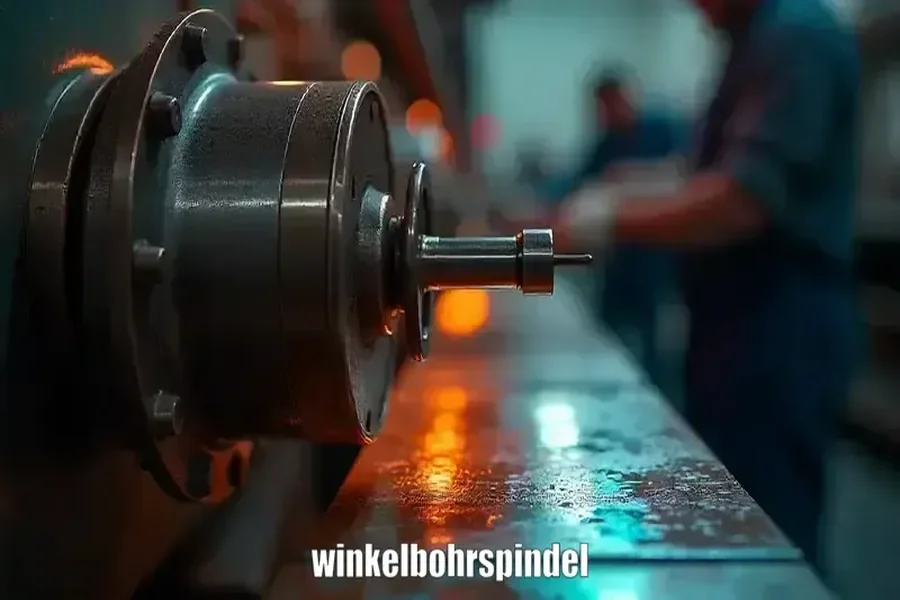In modern industrial production, efficiency, accuracy, and adaptability define competitiveness. Whether producing high-end automotive components, aerospace structures, or intricate medical devices, every part demands precise machining. One often-overlooked component that ensures this precision is the Winkelbohrspindel, or angle drilling spindle. Though small in size, its impact on manufacturing operations is immense, enabling machining at angles that traditional straight spindles cannot achieve.
This article explores the engineering, applications, innovations, and future trends surrounding Winkelbohrspindeln, providing a comprehensive understanding of why this tool is indispensable in contemporary manufacturing.
Understanding the Winkelbohrspindel
The term Winkelbohrspindel originates from German, meaning “angle drilling spindle.” At its core, it is a mechanical device designed to transmit rotational motion from a primary machine spindle to a cutting tool at an angle. The typical configuration allows drilling, tapping, reaming, or milling at angles ranging from 0° up to 120°, with 90° being the most common.
Why Winkelbohrspindeln Are Needed
Imagine a scenario in automotive manufacturing: drilling a hole inside an engine block’s confined cavity. Standard vertical spindles cannot access this region without repositioning the workpiece, increasing setup time and potential errors. A Winkelbohrspindel solves this problem by allowing the tool to reach the required location without moving the part, improving both efficiency and accuracy.
Moreover, these spindles maintain consistent torque, rotational speed, and angular precision, making them ideal for high-tolerance machining in aerospace, medical, and tool-making industries.
Structural Design of a Winkelbohrspindel
The efficiency and reliability of a Winkelbohrspindel stem from its meticulous design. Its main components include:
-
Housing: Typically made from hardened steel, aluminum alloys, or carbon composites, the housing provides structural rigidity, vibration damping, and protection against environmental contaminants. Advanced designs prioritize lightweight structures without compromising stiffness.
-
Angular Transmission System: Bevel gears, spiral gears, or specialized planetary gears redirect torque from the machine spindle to the angled tool. Gear geometry directly impacts torque transmission, angular accuracy, and efficiency.
-
Spindle Shaft: The rotating core holds cutting tools and is engineered to handle high rotational speeds and torque without deformation. High-precision machining of the spindle shaft minimizes vibration and ensures tool longevity.
-
Bearings: Precision ball, roller, or hybrid ceramic bearings maintain smooth rotation under dynamic loads, reducing friction and heat generation.
-
Cooling Systems: Modern Winkelbohrspindeln integrate air, oil, or liquid cooling systems to stabilize temperature, reduce thermal expansion, and prolong operational life.
-
Tool Interfaces: The spindle end often supports HSK, ISO, BT, or ER collets, ensuring compatibility with a wide variety of cutting tools.
Each component’s integration is critical to achieving the precise angular motion required for advanced machining.
How Winkelbohrspindeln Work
The operational principle is elegant yet mechanically sophisticated. Power from the main machine spindle is transferred via a coupling or adapter to the Winkelbohrspindel. Inside, the angular transmission system redirects this power to the tool at the desired angle, typically 90°, though some models allow adjustable configurations.
By maintaining rotational speed and torque, the spindle can execute angled operations without compromising accuracy. This makes Winkelbohrspindeln invaluable in machining complex geometries, curved surfaces, or confined areas.
Types of Winkelbohrspindeln
Winkelbohrspindeln come in various types, each suited for specific industrial needs:
-
Fixed-Angle Spindles: The simplest and most robust type, typically set at 90°. Ideal for repetitive tasks and high-volume production.
-
Adjustable-Angle Spindles: These feature a rotatable head for changing angles, offering versatility for prototype machining or multi-angle operations.
-
High-Speed Spindles: Engineered for operations requiring speeds up to 60,000 RPM, often using hybrid ceramic bearings and precision balancing to reduce vibration.
-
Heavy-Duty Spindles: Designed for high torque output in processing tough materials like steel, titanium, and cast iron.
-
Miniature Spindles: Ultra-compact for micromachining tasks in watches, dental prosthetics, and delicate aerospace components.
Applications Across Industries
The adaptability of Winkelbohrspindeln has made them integral to numerous sectors:
Automotive Manufacturing
Engine blocks, transmission cases, and chassis components often require precise angled holes for fasteners or fluid passages. Winkelbohrspindeln minimize repositioning and reduce production cycle times.
Aerospace Industry
Turbine blades, structural frames, and lightweight components frequently involve angled features. Precision Winkelbohrspindeln ensure high tolerance and surface finish quality crucial for aerodynamics and safety.
Medical Engineering
Surgical instruments, implants, and orthopedic devices require machining at complex angles to meet anatomical and functional specifications. Miniature spindles offer the precision needed for micro-features.
Tool and Die Making
Molds and dies often feature compound angles that standard spindles cannot access. Winkelbohrspindeln enable efficient drilling and milling in these intricate geometries.
Robotics and Automation
Integrated with robotic arms, Winkelbohrspindeln facilitate multi-axis operations in automated production lines, increasing flexibility without manual intervention.
Advantages of Winkelbohrspindeln
The benefits of using Winkelbohrspindeln are significant:
-
Enhanced Accessibility: Machine in tight or obstructed spaces without repositioning the workpiece.
-
High Precision: Maintains alignment and tool path accuracy under high rotational speeds.
-
Time Efficiency: Reduces setup changes and machining cycle times.
-
Versatility: Capable of drilling, milling, tapping, or reaming with the same spindle.
-
Cost-Effectiveness: Minimizes the need for specialized fixtures or multiple setups.
-
Compactness: Lightweight and space-efficient, ideal for limited CNC working envelopes.
Performance Metrics and Specifications
Selecting the right Winkelbohrspindel requires understanding its technical specifications:
| Parameter | Typical Range | Description |
|---|---|---|
| Speed | 1,000 – 60,000 RPM | Determines suitability for various materials |
| Torque | 0.5 – 150 Nm | Defines cutting power for different applications |
| Gear Ratio | 1:1 – 1:2 | Balances torque and rotational speed |
| Angular Accuracy | ±0.01° | Essential for high-tolerance operations |
| Cooling Type | Air / Oil / Water | Ensures thermal stability and longevity |
| Tool Interface | HSK / ISO / BT / ER | Compatibility with machine tools |
These metrics guide engineers in selecting a spindle tailored to their machining tasks.
Maintenance and Longevity
Routine care ensures reliable operation:
-
Lubrication: Regularly grease gears and bearings with manufacturer-approved lubricants.
-
Cleaning: Remove chips, coolant, and debris after each operation.
-
Bearing Inspection: Monitor for unusual noise, vibration, or heat.
-
Gear Alignment Checks: Prevent torque loss and dimensional inaccuracies.
-
Calibration: Periodically adjust angular settings to maintain precision.
With proper maintenance, a Winkelbohrspindel can operate for thousands of hours without failure.
Technological Innovations
Winkelbohrspindeln are evolving alongside Industry 4.0 trends:
-
Smart Sensors: Monitor vibration, temperature, and torque in real-time.
-
Carbon Composite Housings: Reduce weight and improve stiffness.
-
Hybrid Bearings: Enhance speed and longevity with ceramic-steel combinations.
-
Digital Tool Monitoring: Enables predictive maintenance through CNC integration.
-
Modular Designs: Facilitate quick changes between angle and straight spindles.
These developments increase productivity, reduce downtime, and support automated machining workflows.
Choosing the Right Winkelbohrspindel
Factors to consider:
-
Machining Type: Drilling, milling, or tapping.
-
Material: Hard metals require high-torque spindles; soft materials benefit from high-speed versions.
-
Machine Compatibility: Ensure spindle interfaces match CNC systems.
-
Angle Requirements: Fixed or adjustable based on part geometry.
-
Cooling Method: Select air or liquid cooling based on cycle time and heat generation.
Balancing these considerations ensures optimal performance and cost-efficiency.
Safety Considerations
Despite compact design, safety is critical:
-
Secure the spindle firmly before use.
-
Do not exceed maximum RPM or torque limits.
-
Ensure proper coolant application to prevent overheating.
-
Never open the spindle housing while powered.
-
Wear appropriate PPE.
Adhering to safety guidelines prevents accidents and prolongs spindle life.
Common Challenges and Troubleshooting
Even high-quality spindles may encounter issues:
| Problem | Possible Cause | Solution |
|---|---|---|
| Overheating | Excessive speed or insufficient cooling | Adjust RPM or coolant flow |
| Vibration | Unbalanced tool or worn bearings | Rebalance or replace bearings |
| Torque loss | Gear misalignment | Service the internal gear system |
| Noise | Lack of lubrication | Regularly grease the spindle |
| Poor hole accuracy | Angular deviation | Recalibrate the spindle head |
Timely identification and resolution maintain consistent performance.
Environmental Impact and Energy Efficiency
Modern Winkelbohrspindeln support sustainable manufacturing:
-
Energy-Saving Gears: Reduce friction and power consumption.
-
Recyclable Materials: Housing and internal components minimize environmental impact.
-
Noise Reduction: Eco-friendly workshop operations.
-
Extended Life Cycle: Reduces waste and replacement frequency.
These factors align precision machining with green manufacturing initiatives.
Future Trends
The future of Winkelbohrspindeln is intertwined with automation, AI, and sustainability:
-
AI-Controlled Spindles: Enable self-adjusting torque and speed based on material feedback.
-
IoT Integration: Real-time monitoring and predictive diagnostics for smart factories.
-
Hybrid Materials: Combine lightweight and durable materials for efficiency.
-
Miniaturization: Increasing demand for smaller yet high-power spindles in aerospace and robotics.
-
Energy-Efficient Designs: Minimize power consumption without sacrificing performance.
These trends promise greater flexibility, lower operational costs, and higher production quality.
Conclusion
The Winkelbohrspindel is far more than a mechanical accessory; it represents the confluence of precision engineering, innovation, and efficiency. From automotive engine blocks to delicate surgical instruments, this angular spindle allows machining in spaces where conventional spindles cannot reach. Its compact design, high precision, and adaptability make it indispensable across industries.
As manufacturing continues to embrace automation, smart factories, and sustainability, the Winkelbohrspindel will remain a key enabler of complex, high-precision operations. By reducing setup times, enhancing accessibility, and maintaining accuracy under demanding conditions, this small but mighty component ensures that modern manufacturing meets the ever-growing demands of technology, efficiency, and quality.
For More Visits: Techslash

